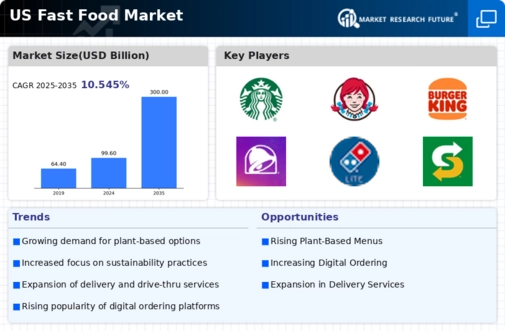Changing Consumer Preferences
The fast food market is currently experiencing a shift in consumer preferences, with an increasing demand for convenience and speed. As lifestyles become busier, consumers are gravitating towards quick-service options that fit their on-the-go needs. This trend is reflected in the growth of drive-thru services and mobile ordering, which have become essential components of the fast food market. In 2025, it is estimated that nearly 70% of fast food sales in the US will occur through drive-thru and delivery services. This evolution in consumer behavior suggests that fast food establishments must adapt their offerings and service models to meet these changing demands.
Focus on Menu Diversification
The fast food market is increasingly focusing on menu diversification to cater to a broader range of dietary preferences and restrictions. As consumers become more health-conscious and adventurous in their food choices, fast food chains are expanding their offerings to include plant-based options, gluten-free items, and international cuisines. In 2025, it is projected that nearly 30% of fast food menus will feature healthier alternatives, reflecting a growing trend towards inclusivity in food choices. This diversification not only meets consumer demands but also positions brands to compete more effectively in a saturated market, potentially enhancing customer loyalty and satisfaction.
Expansion of Delivery Services
The fast food market is witnessing a significant expansion in delivery services, driven by consumer demand for convenience. As more consumers opt for home delivery, fast food chains are partnering with third-party delivery platforms to enhance their reach. In 2025, it is anticipated that delivery sales will account for over 25% of total fast food revenue in the US. This shift not only caters to the growing preference for at-home dining but also presents an opportunity for fast food brands to tap into new customer segments. The integration of delivery services is likely to reshape the competitive landscape of the fast food market, compelling brands to innovate their menu offerings and marketing strategies.
Influence of Social Media Marketing
Social media marketing is becoming an increasingly vital component of the fast food market. Brands are leveraging platforms like Instagram and TikTok to engage with younger audiences and promote their products. In 2025, it is estimated that over 50% of fast food marketing budgets will be allocated to social media campaigns. This trend indicates a shift towards digital engagement, where visually appealing content and influencer partnerships can significantly impact consumer perceptions and purchasing decisions. As social media continues to evolve, fast food brands must adapt their marketing strategies to maintain relevance and attract new customers.
Economic Factors and Pricing Strategies
Economic conditions play a crucial role in shaping the fast food market. With inflation rates fluctuating, consumers are increasingly sensitive to pricing. Fast food chains are responding by implementing value menus and promotional offers to attract budget-conscious customers. In 2025, it is projected that approximately 40% of consumers will prioritize affordability when choosing fast food options. This focus on cost-effectiveness may lead to increased competition among chains, as they strive to provide quality meals at lower prices. Consequently, pricing strategies will likely become a key driver in the fast food market, influencing consumer choices and brand loyalty.
























Leave a Comment